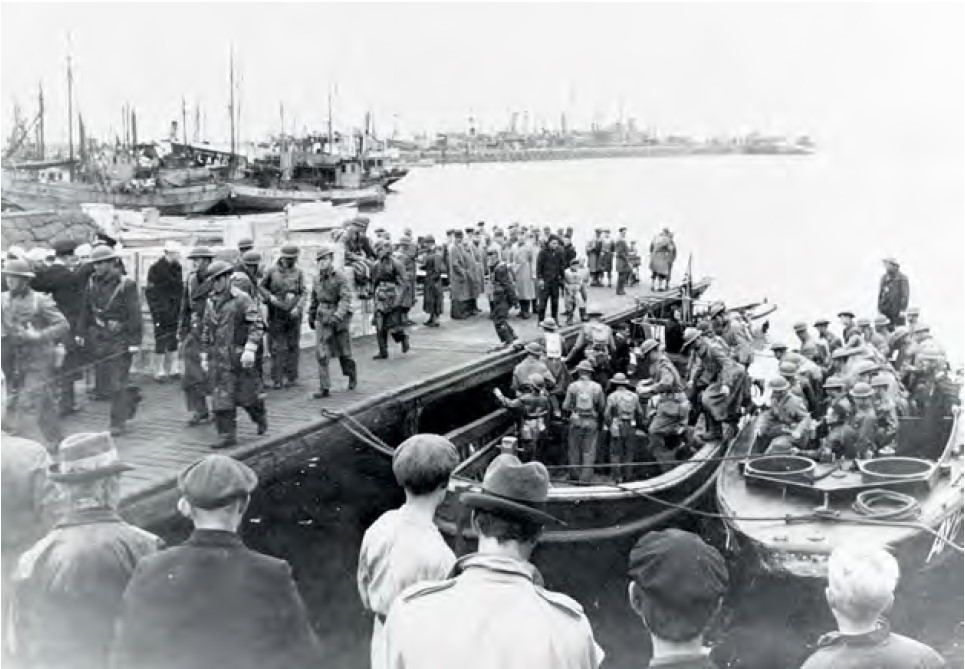
Allied troops arrive in Iceland. [Wikimedia]
In mainland Europe, Hitler’s forces had carried out a blitzkrieg whereby France, Belgium, the Netherlands and Luxembourg would soon fall.
Meanwhile, No. 10 Downing Street had a new occupant in Winston Churchill after his embattled predecessor Neville Chamberlain resigned.
There was, however, a third—if largely since forgotten—event of near-equal notoriety, one in which more than 2,600 Canadians would eventually play a role.
Fearing that Nazi Germany could use Iceland as a staging ground for aerial and naval interception of transatlantic Allied convoys, perhaps even to attack an increasingly vulnerable British Isles, Churchill decided to invade it first.
The mission was codenamed Operation Fork. Despite protests of neutrality, the 120,000-strong Nordic nation—a constitutional monarchy under Danish King Christian X—fell with relative ease as more than 800 British Royal Marines, commanded by Colonel Robert Sturges, landed within Reykjavik harbour.
The men soon spread out across the country, although it quickly became apparent that reinforcements were needed to cover such an enormous landmass. Thus, on May 17, an additional force of 4,000 British troops took over from the marines.
But it was still insufficient—and so Canada was asked to fill the void.
The initial elements of the newly designated ‘Z’ Force, serving under Brigadier Lionel F. Page, set sail from Halifax on June 10, arriving in the Icelandic capital six days later. Ultimately, the bulk of the Canadian contingent comprised The Royal Regiment of Canada, Les Fusiliers Mont-Royal and The Cameron Highlanders of Ottawa (Machine Gun), the latter of which wrote in the regimental war diary that the “view from the boat reminded one of many coloured shoe boxes set around and on a hill.” Unfortunately, such rosy perceptions were quickly discarded.

HMCS Cobalt near Hvalfjörður, Iceland. Canada occupied Iceland following the British invasion in June 1940. [Wikimedia]
Six died. At least two were accidental drownings and one a probable suicide.
A German invasion never materialized, yet issues remained. Among them was a fundamental lack of supplies that plagued ‘Z’ Force from the onset. Far worse, come September 1940, some men still slept in tents when cabins had been promised. There was also the ever-present language barrier with the locals.
Bored from a lack of action—a German aircraft sighting on Feb. 9, 1941, became one of the highlights for the Cameron Highlanders—and plagued with illness, caused in part by chronically foul weather, number of Canadians turned to liquor for comfort.
Of course, it wasn’t all bad. Soccer games with the British were an excellent source of entertainment—even if the Canadians often lost. Horseback riding, climbing and swimming became popular pastimes, as did letter writing. Wherever possible, the troops likewise developed a decent rapport with the Icelandic people, who slowly warmed to their occupiers after reflecting on the potential alternatives—even if a Nazi invasion had always been unlikely at best.
On Oct. 31, 1940—84 years ago this week—most of ‘Z’ Force left Iceland to rejoin 2nd Canadian Infantry Division in Britain. The Cameron Highlanders were temporarily kept on garrison duties, although they, too, pulled out of Reykjavik harbour on April 28, 1941. From June 1940 until the Camerons’ eventual departure, a total of 2,653 Canadians—76 officers and 2,577 other ranks—participated in the 1940-41 occupation of Iceland; of those, six died. At least two were accidental drownings and one a probable suicide.
Canada and Newfoundland’s presence continued with naval ships frequenting Icelandandic waters during the Battle of the Atlantic. Moreover, Canadian-built aerodromes were assets throughout the Second World War, including for the Royal Canadian Air Force’s No. 162 Squadron when later assigned to the Royal Air Force’s Coastal Command.
A further 42 Canadians died in or near Iceland after April 1941.
Advertisement





















